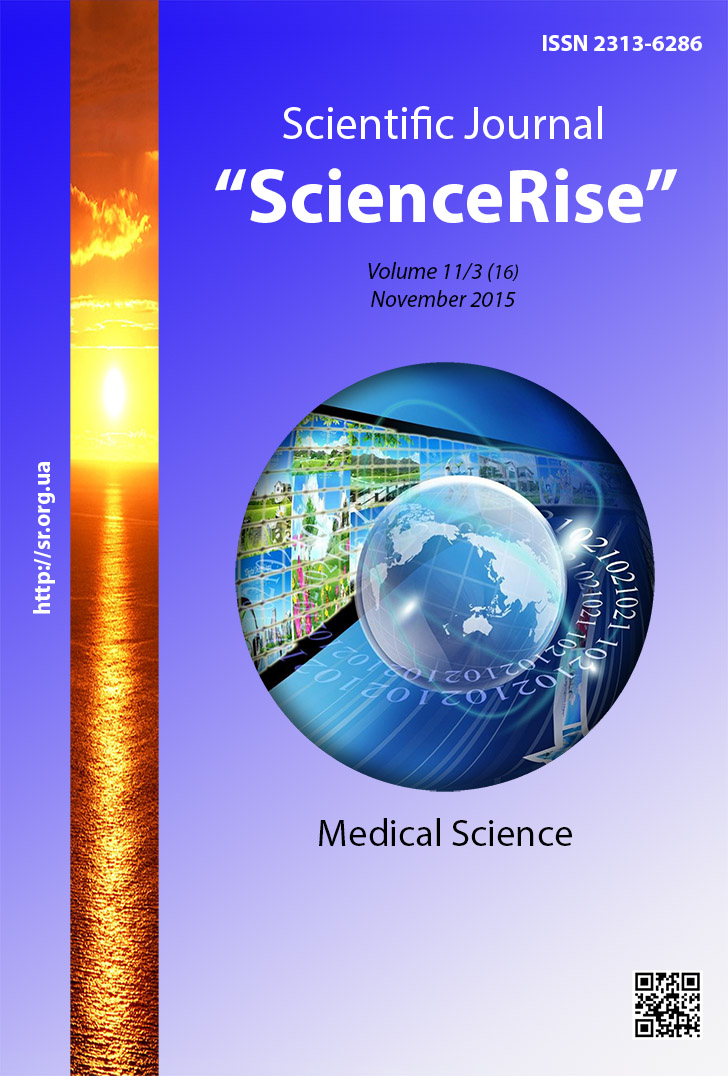Первинна баріатрична операція як етап передопераційної підготовки хворих на рубцеву грижу з супутнім морбідним ожирінням
DOI:
https://doi.org/10.15587/2313-8416.2015.53975Ключові слова:
етапна тактика, морбідне ожиріння, баріатрична операція, відстрочена герніопластика, втрата маси тіла, рецидив грижіАнотація
За результатами дослідження встановлено високу ефективність етапної тактики лікування хворих на рубцеву грижу з супутнім морбідним ожирінням. Баріатрична операція виконана першим етапом - призводить до втрати надлишку маси тіла, нормалізації внутрішньочеревного тиску, купування респіраторних, метаболічних порушень та покращення функціонального стану пацієнтів, що значно покращує умови для виконання герніопластики – другим етапом
Посилання
Yashkov, Y. I., Syneokaya, M. S. (2009). Surgical treatment of obesity and metabolic disorders. Materials Fifth Russian symposium with international participation, 90.
Lavrik, A. S., Tyvonchuk, A. S., Lavrik, A. A. (2013). Surgical treatment of obesity. Ukraine Zdorov’ja, 1, 10–11.
Rao, R. S., Gentileschi, P., Kini, S. U. (2011). Management of ventral hernias in bariatric surgery. Surgery for Obesity and Related Diseases, 7 (1), 110–116. doi: 10.1016/j.soard.2010.09.021
Tsereteli, Z., Pryor, B. A., Heniford, B. T., Park, A., Voeller, G., Ramshaw, B. J. (2007). Laparoscopic ventral hernia repair (LVHR) in morbidly obese patients. Hernia, 12 (3), 233–238. doi: 10.1007/s10029-007-0310-8
Newcomb, W. L., Polhill, J. L., Chen, A. Y., Kuwada, T. S., Gersin, K. S., Getz, S. B. et. al (2008). Staged hernia repair preceded by gastric bypass for the treatment of morbidly obese patients with complex ventral hernias. Hernia, 12 (5), 465–469. doi: 10.1007/s10029-008-0381-1
Autlo, K. M., Janin, O. L., Kruchinin, Je. V., Ivanov, V. V. (2009). Treatment of giant hernias of the anterior abdominal wall in patients with morbid obesity. Materials Fifth Russian symposium with international participation, 20.
Galimov, O. V., Khans, V. A., Shkundyn, A. V., Zyanhyrov, R. A., Muhametov, A. P., Mazytov, A. F. (2010). Education posleoperatsyonnoy hernia in the background of patients to obesity. Clinical Surgery, 8 (809), 8.
Milica, M., Toropov, Y. D., Milica, K. M. (2009). Hernia disease: a new look at pathogenesis. Clinical Surgery, 1, 35–37.
Newman, M. (2011). The Hole in the Wall. Bariatric Times, 8 (4), 16–17.
Breuing, K., Butler, C. E., Ferzoco, S., Franz, M., Hultman, C. S., Kilbridge, J. F. et. al (2010). Incisional ventral hernias: Review of the literature and recommendations regarding the grading and technique of repair. Surgery, 148 (3), 544–558. doi: 10.1016/j.surg.2010.01.008
Novitsky, Y. W. (2006). Laparoscopic Ventral Hernia Repair in Obese Patients. Archives of Surgery, 141 (1), 57. doi: 10.1001/archsurg.141.1.57
1. Yashkov, Y. I., Syneokaya,M. S.(2009). Surgical treatment of obesity and metabolic disorders. Materials Fifth Russian symposium with international participation, 90.
2. Lavrik, A. S., Tyvonchuk, A. S., Lavrik,A. A.(2013). Surgical treatment of obesity. Ukraine Zdorov’ja, 1, 10–11.
3. Rao, R. S., Gentileschi, P., Kini, S. U. (2011). Management of ventral hernias in bariatric surgery. Surgery for Obesity and Related Diseases, 7(1), 110–116. doi:10.1016/j.soard.2010.09.021
4. Tsereteli, Z., Pryor, B. A., Heniford, B. T., Park, A., Voeller, G., Ramshaw, B. J. (2007). Laparoscopic ventral hernia repair (LVHR) in morbidly obese patients. Hernia, 12(3), 233–238. doi:10.1007/s10029-007-0310-8
5. Newcomb, W. L., Polhill, J. L., Chen, A. Y., Kuwada, T. S., Gersin, K. S., Getz, S. B.et. al (2008). Staged hernia repair preceded by gastric bypass for the treatment of morbidly obese patients with complex ventral hernias. Hernia, 12(5), 465–469. doi:10.1007/s10029-008-0381-1
6. Autlo,K. M., Janin,O. L., Kruchinin,Je. V., Ivanov,V. V. (2009). Treatment of giant hernias of the anterior abdominal wall in patients with morbid obesity. Materials Fifth Russian symposium with international participation, 20.
7. Galimov, O. V., Khans, V. A., Shkundyn, A. V., Zyanhyrov, R. A., Muhametov, A. P., Mazytov, A. F. (2010). Education posleoperatsyonnoy hernia in the background of patients to obesity. Clinical Surgery, 8 (809), 8.
8. Milica, M., Toropov, Y. D., Milica, K. M. (2009). Hernia disease: a new look at pathogenesis. Clinical Surgery, 1, 35–37.
9. Newman, M. (2011). The Hole in the Wall. Bariatric Times, 8 (4), 16–17.
10. Breuing, K., Butler, C. E., Ferzoco, S., Franz, M., Hultman, C. S., Kilbridge, J. F. et. al (2010). Incisional ventral hernias: Review of the literature and recommendations regarding the grading and technique of repair. Surgery, 148(3), 544–558. doi:10.1016/j.surg.2010.01.008
11. Novitsky, Y. W. (2006). Laparoscopic Ventral Hernia Repair in Obese Patients. Archives of Surgery, 141(1), 57. doi:10.1001/archsurg.141.1.57
##submission.downloads##
Опубліковано
Номер
Розділ
Ліцензія
Авторське право (c) 2015 Борис Миколайович Кондратенко, Олександр Юрійович Усенко, Андрій Семенович Лаврик, Олександр Степанович Тивончук

Ця робота ліцензується відповідно до Creative Commons Attribution 4.0 International License.
Наше видання використовує положення про авторські права Creative Commons CC BY для журналів відкритого доступу.
Автори, які публікуються у цьому журналі, погоджуються з наступними умовами:
1. Автори залишають за собою право на авторство своєї роботи та передають журналу право першої публікації цієї роботи на умовах ліцензії Creative Commons CC BY, котра дозволяє іншим особам вільно розповсюджувати опубліковану роботу з обов'язковим посиланням на авторів оригінальної роботи та першу публікацію роботи у цьому журналі.
2. Автори мають право укладати самостійні додаткові угоди щодо неексклюзивного розповсюдження роботи у тому вигляді, в якому вона була опублікована цим журналом (наприклад, розміщувати роботу в електронному сховищі установи або публікувати у складі монографії), за умови збереження посилання на першу публікацію роботи у цьому журналі.

